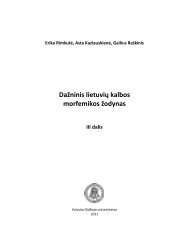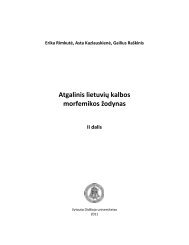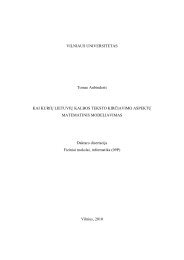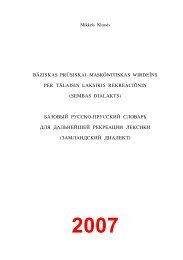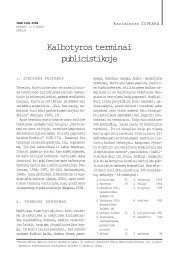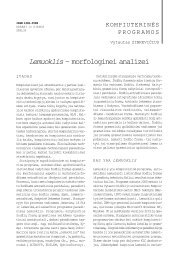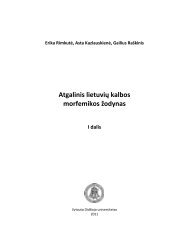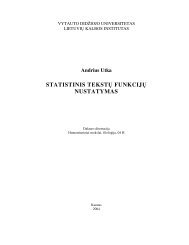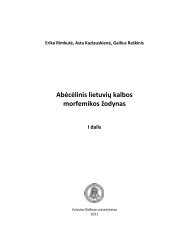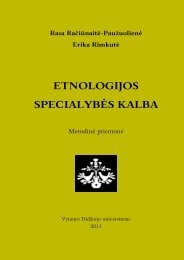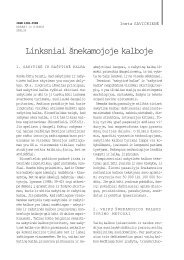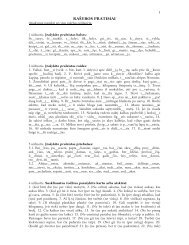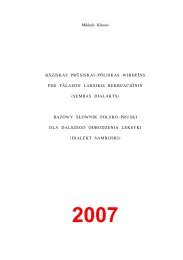HISTORICAL GRAMMAR OF OLD PRUSSIAN
HISTORICAL GRAMMAR OF OLD PRUSSIAN
HISTORICAL GRAMMAR OF OLD PRUSSIAN
You also want an ePaper? Increase the reach of your titles
YUMPU automatically turns print PDFs into web optimized ePapers that Google loves.
<strong>HISTORICAL</strong> <strong>GRAMMAR</strong> <strong>OF</strong> <strong>OLD</strong> <strong>PRUSSIAN</strong><br />
Baltic languages (Lithuanian, Latvian). Athematic verbs ended in Pr. -t<br />
(< *-ti): ast ‘is’ (= Lith. …esti), çit ‘goes’ (= Lith. dial. eµt, Latv. i°et 90 ), d`st<br />
‘gives’ (= OLith. duosti).<br />
Forms of the 3rd person are extended with the formant -ts sometimes:<br />
astits ‘ist es’, pt. bill`ts ‘spoke’ etc. This -ts seems to have come<br />
from WBalt. pron. *tas, used anaphorically. See Stang Vergl. Gr. 410,<br />
cf. Endzelîns SV 105 91 .<br />
* 210. 1 pers. pl. is attested with the morph -mai (see ** 206,<br />
207) in all types of stems. e.g.: asmai ‘we are’ perçimai ‘we come’,<br />
giwammai ‘we live’, l`ikumai ‘we keep’, turrimai ‘we have’.<br />
* 211. 2 pers. pl. possesses morphs -ti (ca. 80x; spelled also -ty),<br />
-tei (9x), -tai (8x), -te (4x), -ta (1x), e.g. asti, estei, astei ‘ye are’, seiti ‘be!’,<br />
laikûtai ‘ye keep’ (in imperative sense), turriti ‘have!’, immaiti ‘take!’, edeitte<br />
‘eat!’, nidrausieiti ‘do not forbid!’, rikauite ‘dominate!’, seggîta ‘do!’. The<br />
morph -te seems to have appeared on place of -tei 92 . The latter has its -tei<br />
in accordance with pattern 2 sg -sei, while -ai in -tai came from 1 pl. -mai;<br />
the spelling -ta (1x) seems to be a mistake. For all this cf. Endzelîns SV<br />
105 f. with bibl. The most frequent (ca. 80x) -ti is authentic < Pr. *-tç<br />
(Endzelîns l. c.) < Balt. *-tç (> Lith.-Latv. *-tç > -te) 93 .<br />
90 Here Latvian acute differs from Lithuanian and Prussian circumflex. – L.P.<br />
91 If (asti)-ts = (ist) es, why (imma)-ts = (nahm) er ? What anaphora can be seen in nostan kai<br />
tans sparts astits prei paskulîton (III 87 10 ) = auff das er mechtig sey zu ermanen ? Why is<br />
anaphoric *tas used in the nominative when corresponds to a direct object: limatz bha daits I 136<br />
– nom. ‘he’ or acc. ‘it (= es)’? (Cf. : “took bread and blessed it, and brake it, and gave it” Math 26<br />
: 26). In all instances -ts occurs only when something is narrated. For Pr. (Cat.) -ts as a mark of<br />
narration (relative mood), as well as for an alternative view of its origin, cf. Borussica 2 in Baltistica<br />
XXV (2) 128–132. – L.P.<br />
92 Here V. Maþiulis de facto recognizes alternation Pr. (Cat.) -ei / -e (cf. ftn's 12, 23, 27, 39, 43, 89,<br />
109). – L.P.<br />
93 V. Maþiulis’ samples show 2 pl. -ti being typical for the imperative mood. Balt. 2 pl. *-tç was<br />
possibly ousted from the indicative by innovative *-tei. If the latter had been really accomodated<br />
to 2 sg. Balt. *-ei, not necessarily to athem. *-sei, its diphthong could occasionally provoce<br />
diphthongization of 1 pl. too (for *-tei cf. EBaltic facts, ftn. 89). As for spellings -tai, -ta, they<br />
may reflect Pr. (Cat.) *-t’ai / *-t’a (= *-tei / *-te) without the letter i as usual mark of palatalization<br />
( o-tiai, o-tia). – L.P.<br />
85



